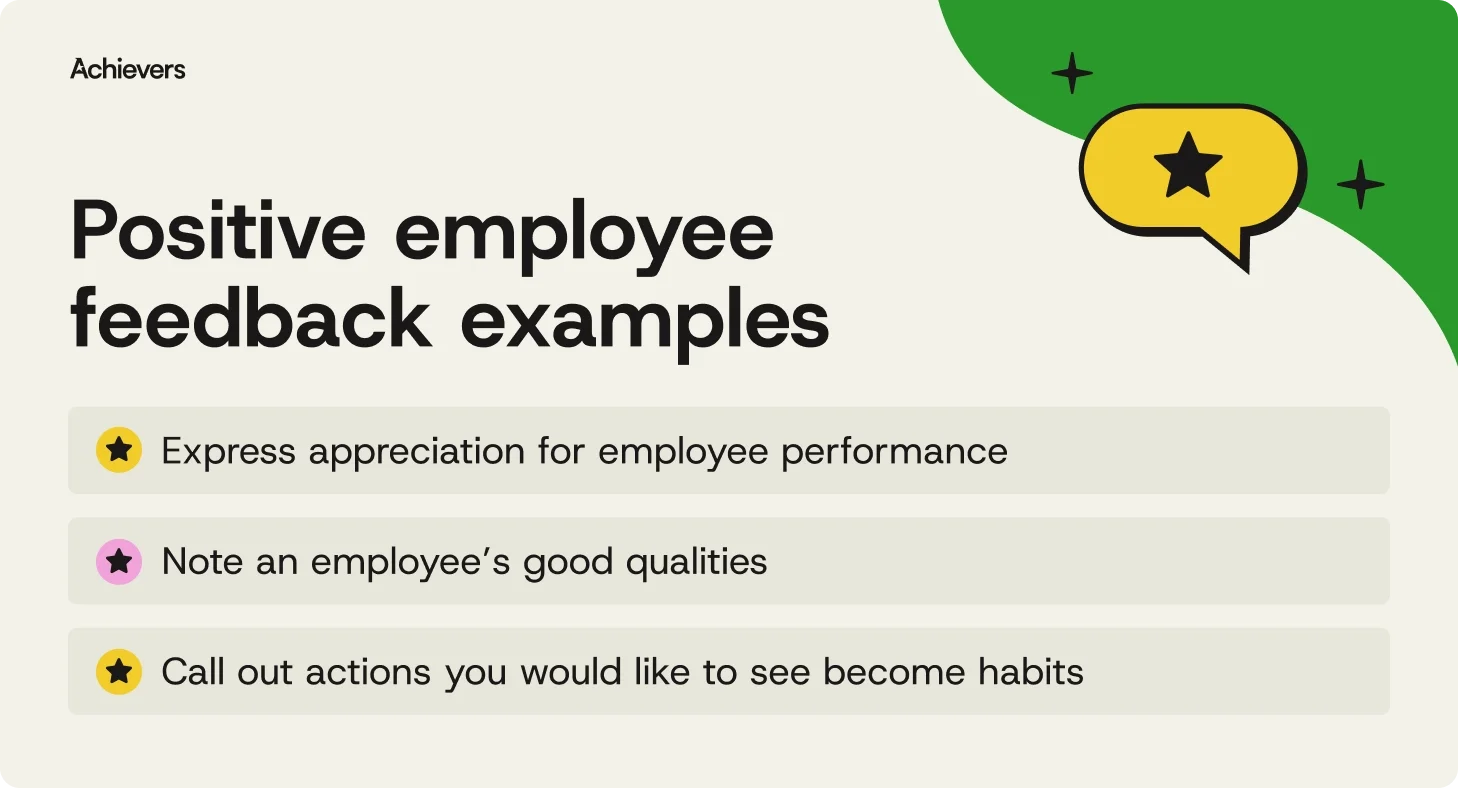Table of contents
“Employee feedback examples” might sound like the stuff of HR training manuals — or awkward performance reviews you’ve been trying to block out. But today, feedback has come a long way from the dreaded annual sit-down. It’s less about formality, more about frequent, real conversations that actually help people do their best work.
And here’s the kicker: 80% of employees who received meaningful feedback in the past week are fully engaged, according to Gallup. That’s not a fluke — it’s proof that a few well-chosen words can make the difference between someone zoning out and buying in.
In this guide, we’ll break down what good feedback looks like, share employee feedback examples that are actually useful, and show you how to respond in ways that build trust, not tension — all with an eye toward building a culture of listening, supported by tools like Achievers.
29 examples of employee feedback
There’s no one-size-fits-all way to give feedback — and that’s a good thing. Different situations call for different approaches, whether you’re celebrating a win, correcting a misstep, or helping someone level up. The examples below offer real, usable language for giving feedback that builds trust, drives growth, and keeps your culture strong.

Positive feedback
Good work deserves more than a thumbs-up emoji. Positive feedback turns small wins into lasting momentum — and shows people their efforts aren’t just noticed, they matter.
1. Express appreciation for employee performance
“What a great job you did on the presentation yesterday! I hear the client was very pleased and may significantly expand the project. Well done. I really appreciate all the hard work, creativity, and energy you put into it.”
When someone nails it, say so — and say why. Specific praise tied to outcomes shows that you’re not just checking a box, you’re paying attention.
2. Note an employee’s good qualities
“I noticed how well you responded to that customer’s concerns. You were patient, understanding, and resourceful. Customer support is an important part of our company brand, and you certainly displayed it.”
Everyone likes to feel seen, not just for what they do, but for how they do it. Name the traits you value, and connect them to the bigger picture.
3. Let employees know when they’re setting a great example
“Jane told me that she is using the new network tool to keep track of sales, based on your positive feedback on the application. Thanks for supporting our new technology and setting a great example for others.”
Model behavior spreads fast, especially when it’s recognized. When someone influences others in a good way, shine a light on it.
4. Call out actions you would like to see become habits
“Thank you for using a spreadsheet to keep track of all the project expenses. It was very helpful for the team, and we were able to keep costs under budget. It was so effective, I’d like to use it on all our future projects.”
If you want more of a good thing, speak up. Feedback like this not only reinforces the behavior; it turns it into a repeatable win.
5. Support employees when difficulties arise, and congratulate them when they persevere
“I understand there have been some very difficult days on the job due to the weather and short supplies. It’s remarkable how you have managed to keep everything running smoothly. I really appreciate your hard work and perseverance.”
Tough situations are when appreciation matters most. Let people know their extra effort isn’t just expected — it’s genuinely valued.
Constructive employee feedback examples
Things won’t always go perfectly — and that’s OK. Constructive feedback helps people adjust, grow, and get back on track without feeling like they’re under the microscope. Here are a few ways to do it well:
6. Follow up when employees fail to meet their goals
“We set performance goals to ensure that both you and our business succeed. Your goals are tied to organizational objectives and affect our overall results. I am concerned that you fell short. Let’s discuss why that happened and what changes we can make to ensure you succeed in the future.”
Missing the mark is part of the job — but silence shouldn’t be. Feedback like this creates space to regroup, reassess, and recommit.
7. Address changes in performance
“You are one of our top salespeople and your results are always excellent. Recently, however, I noticed a decline in your numbers. I was wondering if there is a reason for the change and if there’s anything I can do to help you be successful.”
If performance dips, say something early — and lead with curiosity, not judgment. The goal is to understand, not assume.
8. Touch base when there’s a disconnect
“The results of the IT project were not as successful as I had hoped. The team thought that you were going to be more involved and take on more responsibility. I would like to hear your perspective on the project and talk about how we can avoid misunderstandings in the future.”
Miscommunications happen, especially on fast-moving teams. A calm, clear debrief opens the door to improvement (without finger-pointing).
9. Have a productive discussion about errors
“Unfortunately, the marketing materials that were recently mailed had the wrong logo. I understand that digital assets can be hard to manage, but I thought we had a clear process in place. I’d like to get your perspective on how the mistake happened and how we can avoid it in the future.”
Mistakes are inevitable. What matters is turning them into learning moments, not missed opportunities.
Coaching feedback examples
Coaching feedback is all about potential. It’s how you help people level up without making it feel like a lecture. Done right, it builds confidence, clarity, and trust.
10. Recognition of a skill set
“I’ve noticed you’ve really developed your data analysis skills lately — that dashboard you built was sharp and actionable. Thanks for taking the initiative to level up in that area.”
Coaching starts with noticing. When you call out progress — especially in times of upskilling — you encourage even more of it.
11. How to suggest employees work on soft skills
“You’re great with the technical side of things. I think focusing a bit more on collaboration and communication could really take your work to the next level, especially when working cross-functionally.”
Soft skills can be a blind spot. Framing them as part of growth — not a gap — makes feedback easier to hear and act on.
12. Provide recommendations after a presentation
“Nice job presenting to the leadership team. You had great insights — next time, consider tightening the slide flow to make your main points pop a bit more. Let’s talk through some ways to sharpen it.”
Coaching doesn’t wait for a mistake — it meets employees where they’re already strong and helps them get even better.
13. Acknowledge contributions to company culture
“I heard how you welcomed the new hire and walked them through our team values — that kind of leadership really helps build the culture we’re aiming for.”
Culture isn’t just posters on a wall — it’s shaped by everyday actions. When people walk the talk, call it out.
14. Offer guidance without micromanaging
“You’ve got a solid approach here. If you run into any blockers, let’s check in early so I can support, not slow you down.”
Good coaching isn’t hovering. It’s creating room for ownership and making it safe to ask for help when needed.
Negative employee feedback examples
Negative feedback isn’t about calling someone out. It’s about calling them in. When delivered with care and clarity, it can reset expectations and protect team trust.
15. An employee is displaying toxic behavior
“I’ve heard concerns about comments you’ve made in the lunchroom that others found offensive. We’re serious about maintaining a respectful workplace, and I need you to be more mindful of how your words impact those around you.”
Address it fast, frame it clearly, and focus on the behavior, not the person. You’re drawing a line, not burning a bridge.
16. An employee is continuously late for work
“I’ve noticed you’ve been coming in late frequently. Is there something going on that’s making it difficult to get here on time? Let’s talk through it and figure out a solution together.”
Assume there’s a story behind the behavior. Start with empathy, then move to action.
17. A drop in productivity
“Your output has dipped a bit this month, which isn’t like you. I’d like to understand what’s going on and how I can support you in getting back on track.”
Keep it honest and open-ended. You’re not handing down a verdict — you’re starting a conversation.
18. An employee isn’t participating in team meetings
“I’ve noticed you’ve been pretty quiet in our recent meetings. Is there anything I can do to help you feel more comfortable contributing?”
Not everyone thrives in a group setting, but feedback can help uncover roadblocks and make space for new voices.
19. An employee resists feedback or direction
“I want to have an honest conversation about how we work together. I’ve sensed some resistance when we talk through direction or feedback. I’d like to understand your perspective so we can find a better rhythm.”
When feedback itself becomes the issue, transparency is your best tool. Go there — and go with curiosity.
Appreciation feedback examples
Appreciation doesn’t have to be grand or formal to matter — it just has to be genuine. Whether someone crushed a project, helped a teammate, or showed up strong during a tough week, a simple thank-you can go a long way.
20. Acknowledging achievements outside the workplace
“Congratulations on completing your certification! It’s inspiring to see you invest in your development, and we’re lucky to benefit from it.”
People aren’t just employees — they’re whole humans. Show them you notice the wins that happen off the clock, too.
21. Acknowledge efforts/results on a specific project
“Your contributions really brought this project together. The timeline was tight, but your planning and follow-through made it work.”
Don’t just say “good job.” Say why it was good and what impact it had.
22. Recognize team-focused actions
“Thanks for jumping in to help the team hit that deadline. Your support made a difference, and people noticed.”
Team players keep everything running. Let them know their behind-the-scenes efforts matter.
23. Celebrate resilience during challenges
“I know this week has been rough, but you’ve handled it with grace. Thanks for staying steady and supporting others along the way.”
Appreciation doesn’t always need a trophy moment. Sometimes, a little acknowledgment is everything.
Upward feedback
Managers need feedback, too. When upward feedback is welcomed (not punished), it builds better leaders and stronger teams — one honest convo at a time.
24. Expressing feelings of stress
“I’ve been feeling a bit overwhelmed with the current workload and wanted to flag it before it affects my performance. Can we talk about prioritization?”
When people can name stress early, it helps managers solve the right problems before burnout sets in.
25. Expressing feelings of burnout
“I’ve been feeling stretched thin for a while now. I’m still committed, but I think we need to reassess what’s sustainable long term.”
This kind of honesty is a gift — and a chance for leaders to create a more supportive, balanced environment.
26. Requesting clearer expectations
“It would really help to have more clarity on what success looks like for this project — I want to make sure I’m hitting the mark.”
Sometimes the feedback isn’t about too much direction — it’s about not enough. Invite the ask.
Formal feedback
Performance reviews don’t have to feel like walking into a dentist’s office. Formal feedback, when it’s done well, gives employees clarity, direction, and something to build on, not just file away.
27. Employee performance reviews
“This review reflects the impact you’ve made this quarter — from improving delivery timelines to mentoring new team members. Let’s talk about what’s next for your growth.”
Performance reviews work best when they’re a springboard, not a scoreboard.
28. 1:1 manager meetings
“In our 1:1s, I want to make sure we’re not just reviewing tasks, but also checking in on how you’re doing and where you want to grow.”
A good 1:1 isn’t a status update. It’s an ongoing conversation about work and your employees’ well-being.
29. Progress tracking
“Looking back at our last few check-ins, I can see real progress on your development goals. Let’s build on that and set a few new stretch areas.”
Formal feedback helps you track growth and spotlight momentum.
How to provide feedback to employees
Feedback doesn’t need a script, but it does need a strategy. Here’s how to make it land (and not backfire):
- Be timely, specific, and tied to outcomes: Say it while it’s fresh. Vague praise or delayed critique won’t help anyone grow.
- Make it a two-way conversation: Ask, listen, and learn. Feedback is more useful when it doesn’t come from a soapbox.
- Find the right balance: Mix praise with direction. One without the other is either noise or a morale killer.
- Match the tone to the message: Shout wins from the rooftops. Handle tough stuff with care and privacy.
- Lead with empathy and respect: Don’t assume. Don’t attack. People hear you more clearly when they don’t feel cornered.
- Focus on actions, not identity: Call out actions, not character. It’s easier to fix a habit than a personality.
Employee feedback examples, powered by insight — and Achievers
Listening is one thing. Acting on it? That’s where trust is built.
Achievers’ Voice of Employee (VoE) solution helps you go beyond surface-level feedback with tools that are built to spark change, not just collect opinions. Here’s how it works:
- Surveys and polls to measure employee sentiment, alignment, and experience in real time
- Post-event feedback and check-ins to capture moments that matter — from onboarding to exit
- 100+ customizable templates so you’re never starting from scratch
- Quizzes and forms that keep engagement high and feedback flowing
- Self-serve analytics to turn raw data into clear, next-step insights
- HRIS integrations to keep everything connected and actionable
And because it all lives in one platform — alongside our recognition and rewards platform — you can connect feedback to real outcomes. When employees see their input lead to action, it doesn’t just improve engagement. It builds a culture of listening that people actually believe in.
Turn employee feedback examples into culture-shaping action
Employee feedback examples are only useful if they lead somewhere. When they’re consistent, specific, and followed by action, they don’t just improve performance — they shape culture, boost retention, and build real trust.
Achievers’ Voice of Employee solution makes that possible. With built-in tools for capturing insights and closing the loop, you can move from “we’re listening” to “we heard you, and here’s what’s next.”



